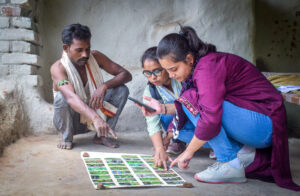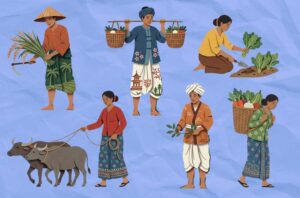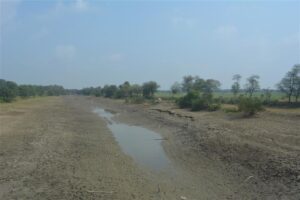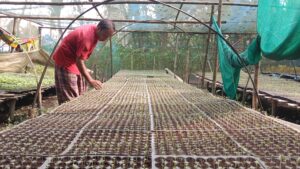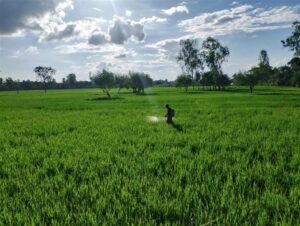by Nelissa Jamora and Venuprasad Ramaiah
This study was motivated by a need to document and understand how genebank users make use of genetic resources to enhance access to, and promote the use of, rice germplasm. The findings debunk a misconception that accessions stored in genebanks are rarely used and justify why genebanks must be supported in the long term. Indeed, the demand for germplasm and genebank services is expected to increase because of climate change and global development goals to maintain or increase crop diversity.
This study examined patterns of germplasm use for the largest rice diversity collection in the world, managed by the International Rice Genebank (IRG) of the International Rice Research Institute (IRRI). Rice is a staple food for more than half of the world’s population. In 2019, over 755 million tons were produced in 143 countries.
Research, breeding, and other crop improvement efforts have focused on enhancing yield and addressing consumer preferences in quality and nutrition. As a result, global rice production has continued to increase over the last several decades. However, while productivity is still increasing overall, the rate of increase has been declining.
Long-term experiments at IRRI have confirmed yield stagnation due to several factors, including “soil-related factors and gradual depletion of key nutrients, a downward shift in nutrient response function, and changes in the climate”. Hence, maintaining yield growth is crucial to meet future consumption because challenges continue to evolve with climate change and the emergence of new pests and pathogens in combination with a decrease in the land available for rice production.
The IRG was officially established in 1977. Shortly after IRRI’s founding, scientists began to assemble a germplasm collection to support its breeding work. Today, IRRI holds the world’s largest collection of rice diversity, with more than 132,000 accessions of cultivated rice and wild species.
There are 24 species of rice belonging to the genus Oryza, and two species are the most important for global production: (1) O. sativa, cultivated worldwide, and (2) O. glaberrima, grown mainly in parts of Africa. These genetic resources are the foundation for rice improvement, which is necessary to sustain growth and improve quality in food production.
Plant genetic resources (seeds or other germplasm) are used in many ways, with farmers planting crops as the most obvious and direct application. However, rice germplasm from IRRI is mainly used at an earlier stage by researchers seeking to develop improved varieties. There is ample evidence that the continuous release of improved varieties by public plant breeding programs has brought about social and economic returns that far outweigh the costs of investment.
The economic impact of the initial diffusion of modern rice varieties across Asia from the 1960s through the 1980s is one of the best documented achievements in international agricultural research and development assistance. The estimated value of farm-level benefits from crop improvement that would be gained by adding 1,000 additional accessions to the rice collection maintained by the International Network for the Genetic Evaluation of Rice is at USD 325 million.
A study demonstrated that there had been large and sustained yield gains flowing to the Philippines, Indonesia, and Vietnam resulting from IRRI’s work on varietal improvement. The estimated total benefits averaged USD 1.46 billion (in constant 2009 dollars) per year across the three countries. Estimated similar substantial returns attributable to IRRI for varieties released after 1989 in Bangladesh, Indonesia, and the Philippines confirmed that germplasm from IRRI contributed 16.4% of genetic materials to rice varieties developed in China between 1982 and 2011.
A recent study estimated the contribution of IRRI’s genetic resources to varietal improvement and rice productivity of farmers in eastern India that 45–77% of the genetic composition of improved rice varieties was derived from the genes of IRRI genebank accessions. Further, a 10% increase in the genetic contribution of IRRI’s materials to an improved rice variety was associated with a yield increase of 27%.
This study was motivated by a need to document and understand how genebank users make use of genetic resources to enhance access to, and promote the use of, rice germplasm. The findings debunk a misconception that accessions stored in genebanks are rarely used and justify why genebanks must be supported in the long term.
Recipients of materials from the genebank confirmed the usefulness of the materials for many purposes. Public sector organizations and the scientific community, particularly in developing countries, benefitted from the availability of rice genetic resources and are expected to continue benefiting in the future. Indeed, the demand for germplasm and genebank services is expected to increase because of climate change and global development goals to maintain or increase crop diversity.
Trends in the use of rice germplasm indicate the importance of maintaining collections that include wild species, landraces, and genetic stock, as well as research and breeding accessions for developing drought tolerance and disease resistance.
The findings presented here have important implications for the conservation and use of rice genetic diversity in the future. First, improving the availability of data on conserved germplasm, including economic studies to better understand the changing demand of users, must be a priority for enhancing the use of rice germplasm at IRRI.
The increased availability of genomic data, for example, could allow users of germplasm to select materials much faster and more cheaply based on genotype rather than on phenotype. The growing demand for rice genetic stocks at the IRRI genebank confirms this emerging trend. Innovations in technology, however, require complementary and continuous investment in genebanks to allow them to evolve and make full use of new knowledge.
Second, the feedback from the user survey demonstrated the extent of the use of rice germplasm and the magnitude and range of benefits generated by the IRRI genebank. The conservation and management of genetic resources benefit not only the requesters but also the multitude of indirect users of germplasm in research and breeding programs from a range of institutions in both low- and high-income countries.
However, political uncertainties concerning the enhancement of the MLS and the regulation of access to genetic resources outside the MLS may restrict the acquisition of new materials to include in the international crop collections and the distribution of germplasm to recipients around the world.
The role of IRRI’s genebank in ensuring that the benefits from the use of rice diversity will continue to be accessible to future generations cannot be overestimated nor undermined. It is vital not to endanger the raw materials that will provide us with the options to address food and nutrition security challenges in a changing climate and agricultural context.
Read the study:
Jamora N and Ramaiah V. (2022) Global demand for rice genetic resources. CABI Agric Biosci 3, 26 .

